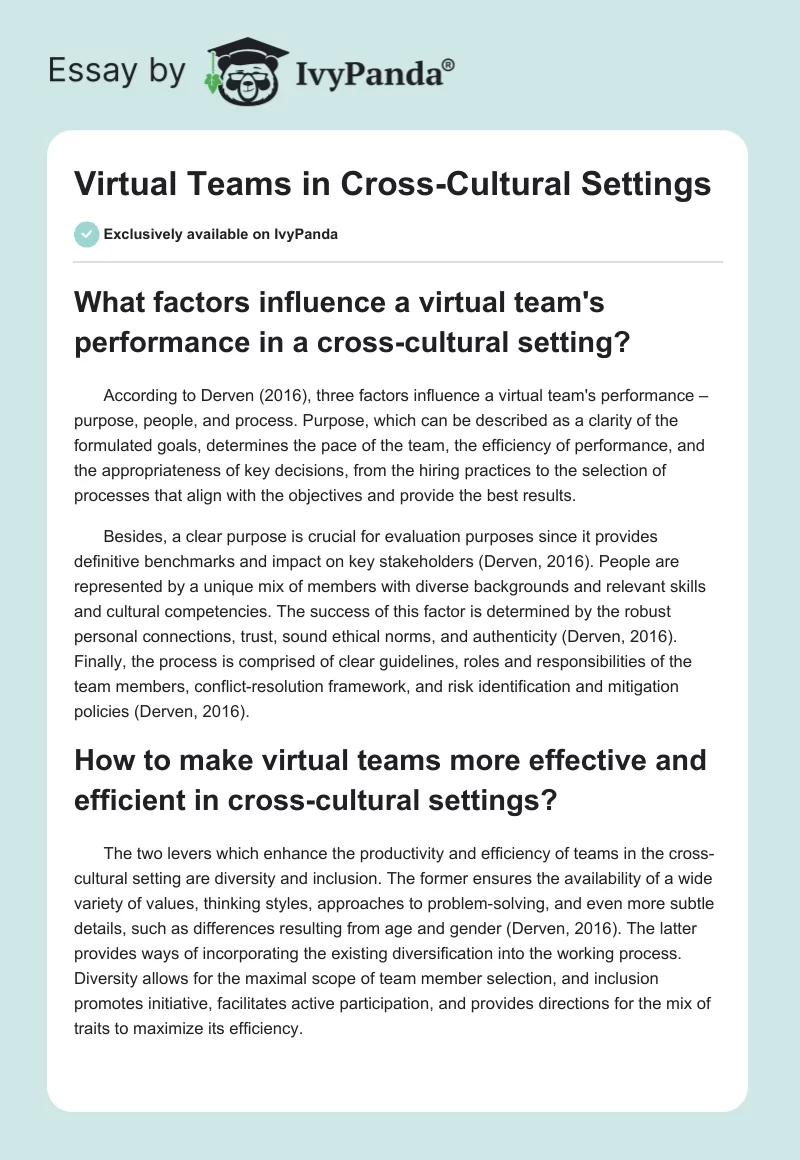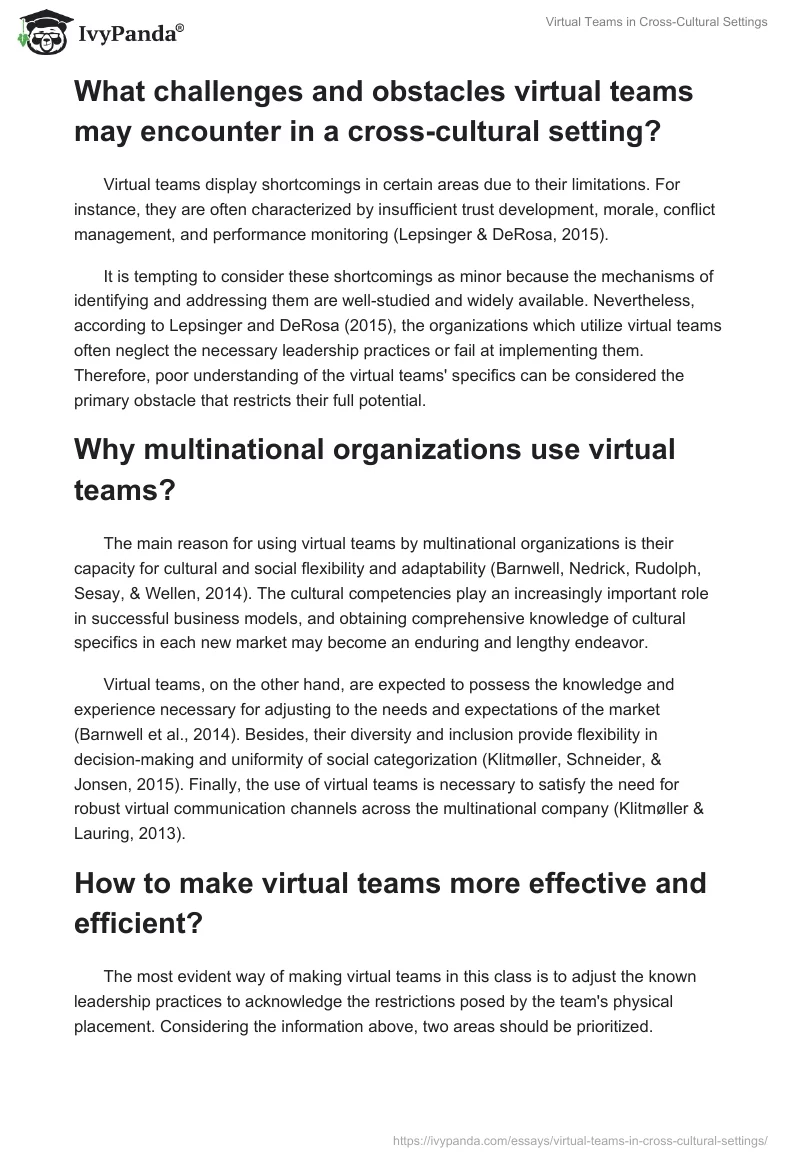What factors influence a virtual team’s performance in a cross-cultural setting?
According to Derven (2016), three factors influence a virtual team’s performance – purpose, people, and process. Purpose, which can be described as a clarity of the formulated goals, determines the pace of the team, the efficiency of performance, and the appropriateness of key decisions, from the hiring practices to the selection of processes that align with the objectives and provide the best results.
Besides, a clear purpose is crucial for evaluation purposes since it provides definitive benchmarks and impact on key stakeholders (Derven, 2016). People are represented by a unique mix of members with diverse backgrounds and relevant skills and cultural competencies. The success of this factor is determined by the robust personal connections, trust, sound ethical norms, and authenticity (Derven, 2016). Finally, the process is comprised of clear guidelines, roles and responsibilities of the team members, conflict-resolution framework, and risk identification and mitigation policies (Derven, 2016).
How to make virtual teams more effective and efficient in cross-cultural settings?
The two levers which enhance the productivity and efficiency of teams in the cross-cultural setting are diversity and inclusion. The former ensures the availability of a wide variety of values, thinking styles, approaches to problem-solving, and even more subtle details, such as differences resulting from age and gender (Derven, 2016). The latter provides ways of incorporating the existing diversification into the working process. Diversity allows for the maximal scope of team member selection, and inclusion promotes initiative, facilitates active participation, and provides directions for the mix of traits to maximize its efficiency.
What challenges and obstacles virtual teams may encounter in a cross-cultural setting?
Virtual teams display shortcomings in certain areas due to their limitations. For instance, they are often characterized by insufficient trust development, morale, conflict management, and performance monitoring (Lepsinger & DeRosa, 2015).
It is tempting to consider these shortcomings as minor because the mechanisms of identifying and addressing them are well-studied and widely available. Nevertheless, according to Lepsinger and DeRosa (2015), the organizations which utilize virtual teams often neglect the necessary leadership practices or fail at implementing them. Therefore, poor understanding of the virtual teams’ specifics can be considered the primary obstacle that restricts their full potential.
Why multinational organizations use virtual teams?
The main reason for using virtual teams by multinational organizations is their capacity for cultural and social flexibility and adaptability (Barnwell, Nedrick, Rudolph, Sesay, & Wellen, 2014). The cultural competencies play an increasingly important role in successful business models, and obtaining comprehensive knowledge of cultural specifics in each new market may become an enduring and lengthy endeavor.
Virtual teams, on the other hand, are expected to possess the knowledge and experience necessary for adjusting to the needs and expectations of the market (Barnwell et al., 2014). Besides, their diversity and inclusion provide flexibility in decision-making and uniformity of social categorization (Klitmøller, Schneider, & Jonsen, 2015). Finally, the use of virtual teams is necessary to satisfy the need for robust virtual communication channels across the multinational company (Klitmøller & Lauring, 2013).
How to make virtual teams more effective and efficient?
The most evident way of making virtual teams in this class is to adjust the known leadership practices to acknowledge the restrictions posed by the team’s physical placement. Considering the information above, two areas should be prioritized.
First, the lack of visual contact needs to be acknowledged, and its adverse effect on mutual understanding must be mitigated. Second, accessible and transparent means of the performance evaluation must be used to compensate for the shortcomings of traditional systems. This can be done either on a technological level (by providing software tools with tracking capabilities) or by shifting the focus of leadership practices (by communicating the importance of evaluation and ensuring commitment and involvement of the team).
References
Barnwell, D., Nedrick, S., Rudolph, E., Sesay, M., & Wellen, W. (2014). Leadership of international and virtual project teams. International Journal of Global Business, 7(2), 1-8.
Derven, M. (2016). Diversity and inclusion are essential to a global virtual team’s success. Web.
Klitmøller, A., & Lauring, J. (2013). When global virtual teams share knowledge: Media richness, cultural difference and language commonality. Journal of World Business, 48(3), 398-406.
Klitmøller, A., Schneider, S. C., & Jonsen, K. (2015). Speaking of global virtual teams: language differences, social categorization and media choice. Personnel Review, 44(2), 270-285.
Lepsinger, R., & DeRosa, D. (2015). How to lead an effective virtual team. Web.


